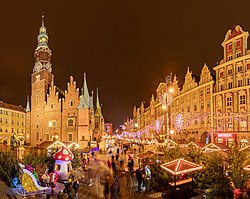User:Luziyca/Sandbox
Krada | |
|---|---|
City | |
 | |
| Motto: TBD | |
| Country | |
| Voivodeship | Święciżar |
| Founded | 6 December, 1103 (traditional) |
| Government | |
| • Mayor | TBD |
| Population (2017) | |
| • City | 891,411 |
| • Rank | 2nd in Lemovicia |
| • Urban | 891,411 |
| • Metro | 1,129,050 |
| Time zone | TBD |
| • Summer (DST) | not observed |
Krada is the largest city of the Miersan Federation, situated in the Święciżar voivodeship. As of the 2017 census, the urban area of Krada has a population of 891,411 people, making it the largest city fully under the control of West Miersa.
First founded around the twelfth century as a fort to deter bandits on one of the major trade routes, Krada was a minor settlement. (TBC)
Etymology
The name Krada is believed to derive from the masculine singular present transgressive form of the Proto-Marolevic word *kràsti, or "to steal," suggesting that the area around Krada was historically a hotspot for banditry, with bandits based in present-day Krada often preying on the trade routes going over the Środek connecting northern and southern Euclea.
History
Prehistory
Middle Ages
Krada first appears in the historical record around 1100 CE, when the voivode of Święciżar ordered the construction of a fort to "guard the trade routes" into the Środek. Tradition gives the fort's construction as taking place on 6 December, 1103, or on the feast day of Saint Nicholas.
Despite its position on the trade routes, Krada never became a prominent destination on the north-south Euclean trade routes, as most of the goods tended to go towards the coasts, or towards TBD, where they could be transported west to Pavatria, or east towards TBD.
(TBC)
Renaissance
Interregnum
Early Narozalic rule
Industrial Revolution
Great War
Independence
Modern era
Geography
Government
Demographics
Culture
As the largest city under West Miersan control, Krada has become a major cultural centre, particularly given most of its residents have origins across all of Miersa.
(TBC)